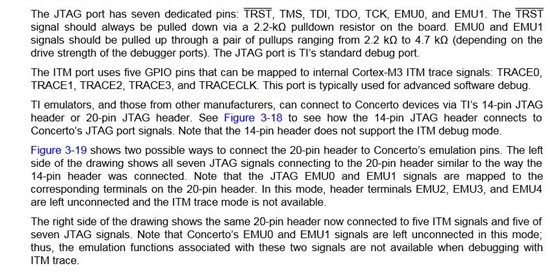Hi,
We are going to use a TI-Concerto (F28M36P63C2) for a prototype-development and are looking for a emulator which fits our needs. In this context we are interested in the traceability of the ARM Cortex-M3. Following the TI “Trace Analyzer User’s Guide” (http://www.ti.com/lit/ug/spruhm7b/spruhm7b.pdf -> see page 71 & 72), “Data Variable Tracing” and “Interrupt Analyzer” uses SWO trace transport type and requires a XDS200-type emulator. According to the processor wiki (http://www.processors.wiki.ti.com/index.php/Cortex_M3_ITM_Support_for_Concerto_F28M35x), the required emulator for trace functionality is the XDS560v2.
Questions concerning this information:
- Which statement is correct? Does the XDS200 really support trace functionality or do we need the XDS560v2?
- Which additional features are provided by the USB560v2?
Additionally we are wondering, which JTAG-Header we should use and how to connect the Concerto to it. TI recommends to use the TI 20 pin JTAG Header, if using the Cortex-M3 ITM trace signals (http://www.ti.com/lit/ds/symlink/f28m36p63c2.pdf -> see page 85 & 87). Unfortunately it is not possible to connect both, EMU0 & EMU1 of the standard JTAG-Port and TRACED0…3 & TRACECLK(see page 87). According to the Data Manual, without EMU0 & EMU1 the emulation functions associated with these two signals are not available(see page 85).
Questions:
- Which functions are missing, without EMU0 & EMU1 ? software-breakpoints? Other standard debug features?
- Is there an option to keep full standard debug functionality and use the trace functions simultaneously?
Maybe by using a different Header? If yes: Which header and how to connect it to the concerto?
Which emulator works with this combination?
I’m searching for answers to these questions for a while. Blackhawk-Support told me to ask TI-Support for specific features, because their emulator are based on TI reference design. I would appreciate if you could help me to answer these questions and find the right emulator for my project.
Best regards
Ken


